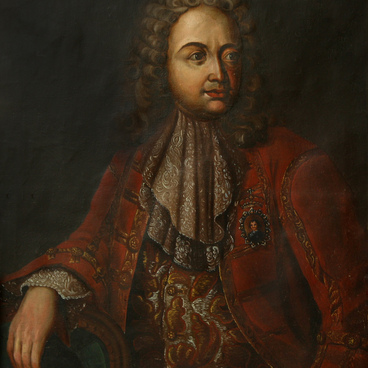The drawing by Pyotr Ivanovich Subbotin-Permyak, the founder of the Komi-Permyak Local History Museum, was handed over to the museum by his wife in 1930. The pencil sketch shows a seated middle-aged man and woman in peasant clothing. The woman is dressed in a long zipun — a winter homespun coat worn by Komi-Permyaks — and lapty — straw shoes. She wears a headscarf, which is tied at the back in a traditional way. The man is dressed in a similar zipun and lapty with footwraps; to his right is a large sack.
Pyotr Ivanovich Subbotin-Permyak was the first professional Komi-Permyak painter, a representative of the Russian avant-garde art, a professor of painting, and a public figure. Pyotr Ivanovich organized art and industrial workshops in the Perm Governorate, founded the Kudymkar Museum, and the theater workshops in Kudymkar and Usolye. His artistic legacy consists of more than 50 paintings, 40 graphic works, 30 theatrical sketches, 50 sketches of festive decoration of Moscow for the first anniversary of the Red Army.
His early works followed the traditions of classical and decorative painting. Later he got fascinated by new techniques of depicting the world around, which were peculiar to the early 20th century. His paintings displayed some influence of Impressionism and Futurism. Subbotin-Permyak’s graphic works created in 1910-1915 make up a realistic series called “Komi-Permyaks” and provide a vivid insight into the everyday life of the people. His drawings show the Komi-Permyak folk costume, household items, facial features and typical characters of Komi-Permyaks.
Pyotr Ivanovich Subbotin-Permyak often turned to the genre of landscape: he painted and drew wooden buildings, log cabins with ridge beams, Permyak stables and barns; vegetable gardens, hedges, wicker fences, backyards and ravines, and also the grassy banks of the Inva and Kuva rivers, where the artist spent his childhood. As of today, 16 such sketches have survived, all of them conveying the atmosphere of the Kama region.
Pyotr Ivanovich Subbotin-Permyak lived only 36 years. He was buried in the Egoshikhinsky cemetery in Perm. In Kudymkar there is the house-museum of the artist. A monument to Pyotr Ivanovich Subbotin-Permyak was erected near the museum of local history named after the artist.
Pyotr Ivanovich Subbotin-Permyak was the first professional Komi-Permyak painter, a representative of the Russian avant-garde art, a professor of painting, and a public figure. Pyotr Ivanovich organized art and industrial workshops in the Perm Governorate, founded the Kudymkar Museum, and the theater workshops in Kudymkar and Usolye. His artistic legacy consists of more than 50 paintings, 40 graphic works, 30 theatrical sketches, 50 sketches of festive decoration of Moscow for the first anniversary of the Red Army.
His early works followed the traditions of classical and decorative painting. Later he got fascinated by new techniques of depicting the world around, which were peculiar to the early 20th century. His paintings displayed some influence of Impressionism and Futurism. Subbotin-Permyak’s graphic works created in 1910-1915 make up a realistic series called “Komi-Permyaks” and provide a vivid insight into the everyday life of the people. His drawings show the Komi-Permyak folk costume, household items, facial features and typical characters of Komi-Permyaks.
Pyotr Ivanovich Subbotin-Permyak often turned to the genre of landscape: he painted and drew wooden buildings, log cabins with ridge beams, Permyak stables and barns; vegetable gardens, hedges, wicker fences, backyards and ravines, and also the grassy banks of the Inva and Kuva rivers, where the artist spent his childhood. As of today, 16 such sketches have survived, all of them conveying the atmosphere of the Kama region.
Pyotr Ivanovich Subbotin-Permyak lived only 36 years. He was buried in the Egoshikhinsky cemetery in Perm. In Kudymkar there is the house-museum of the artist. A monument to Pyotr Ivanovich Subbotin-Permyak was erected near the museum of local history named after the artist.




